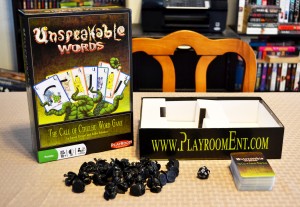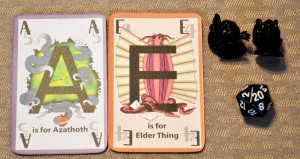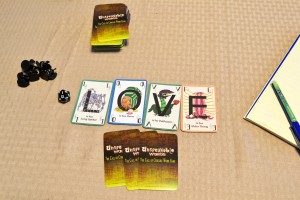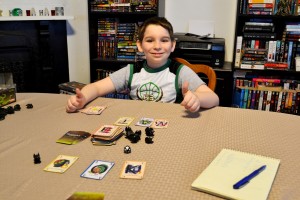After a fairly successful experience with the video game adaptation of “Elder Sign: Omens”, I decided to take another plunge into the world of H.P. Lovecraft. Only this time, I’ll be trying to form words with the available letters without going crazy. The trick lies in both the length of the word, as well as how many angles are present in the letters used to form said word. Who will go insane and who will manage to escape the funny farm by the skin of the teeth? Only time (and perhaps a few visits from Cthulhu) will tell…
Components
Letter Cards – There are a total of ninety-six letter cards, each containing a single letter. Each card lists the number of angles the letter contains on the corner of the card for easy reference.
Cthulhu Pawns – There are a total of thirty Cthulhu pawns. These serve as a sanity meter of sorts.
Twenty-sided die – The game included a twenty-sided die, which is used every time there is a sanity check.
Paper and Pencil (Not Included) – You’ll need a paper and pencil in order to keep score.
Setup & Gameplay
The deck of cards is shuffled. Each player receives seven cards to form their starting hand and five Cthulhu pawns. On a player’s turn, they’ll use some or all of their cards to form a valid word. Once the word is played, the player will add up the number of angles on each respective letter (the number is faded on the corners of the card for easy reference) to determine the word’s score. Once players have this number, they’ll roll the twenty-sided die and compare the two values. If the die roll is less than the word’s score, then the player loses one Cthulhu pawn. Whether or not the player lost a pawn, the word and the word’s score is written down on a separate scoring sheet (not included). A word can not be used twice during the same game.
Some other things to note:
1) Once a player is down to one Cthulhu pawn, they can invent any word they like and don’t have to conform to words in the dictionary.
2) If a player is out of Cthulhu pawns, they are eliminated from the game.
3) A roll of 20 during a sanity check automatically wins the check.
4) When a word will score a player to or past one hundred points, they MUST pass a sanity check. If they don’t, they score zero for the round.
5) Instead of playing a word, the player can discard all seven cards to get seven new ones. This will end the player’s turn.
The first player to reach one hundred points wins! If all other players have gone insane (by losing all of their Cthulhu pawns), the remaining player wins by default.
The Review
The components were fairly colorful and well-themed. I’m not all that big on Lovecraftian lore, but the cards certainly had a monstrous appeal about them. The rules were easy to understand and we were well on our way within five minutes of opening the box. With that being said, we discovered that the game could be modified in a few ways to add some spice to the original rule set. For example, sanity checks could be compared with the cards left in a player’s hand after forming a word and not the word itself. If you eliminate the point threshold (one hundred points), you can simply play to see who will survive the longest. Feel free to make your own house rules! For those of you who are curious, the manual does list four other variants to try out so that players can mix things up.
While the game relies a bit on the dice to determine the results of a sanity check, it actually serves to give players some strategic choices. Players have the option of playing it safe with smaller words with less angles to increase their chances of passing the sanity check, though there are no guarantees. It’s very possible to lose a sanity check on a word score of three if the die hates you that day. By that same token, you can play larger words with a lot of angles in the hopes of inflating your score quickly, though you run the risk of being eliminated early on since sanity checks are harder to pass this way.
I’ll opt to keep this review short and sweet, mainly due to the ease of which this game plays. There aren’t any special gimmicks or rules…just you, the words you form, and sanity checks. It’s a simple concept that will attract players of all ages. The game is kid-friendly as well, making it a great educational tool when it comes to vocabulary, spelling, and math. The art isn’t all that gruesome, but teachers should double-check their school policy before introducing it to their classroom just to be on the safe side. All in all, a wonderful little card game!
Final Verdict: 9/10
—




